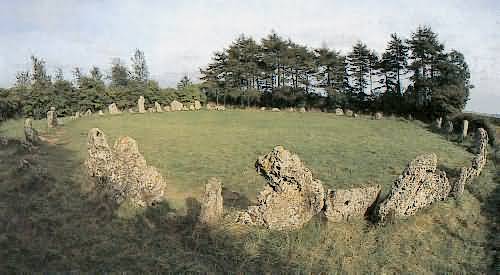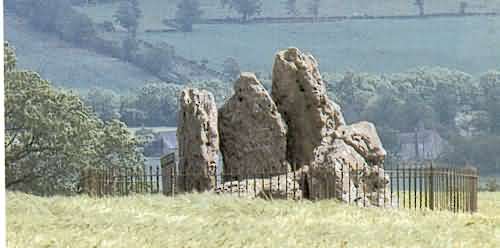| Seven miles from Stow-on-the-Wold in a north-easterly direction,
on the road to Long Compton, and near the village of Little Rollright,
is a circle of standing stones, the most easterly in England. Other
stones stand close by.
The road that passes the site follows the line of an ancient trackway
along a high ridge, the only way early people could move with relative
ease. Today we call it the Jurassic Way, just a country lane, but
a very important route in prehistoric times.
If you are travelling from Stow-on-the-Wold the circle is on your
right, but because of a thick hedge it could easily be missed.
And that’s one of the charms of the place, no big signs or
tasteless visitor centre and no acres of tarmac for car parking,
just a couple of lay-bys with a path through the hedge past a small
hut.

Follow the path which leads out into a small field and there you
are confronted by 77 unhewn stones varying from ground level to
about 7 feet in height and arranged in a perfect circle of 100
feet diameter. They were built between 4000 and 4500 years ago
by late Stone Age people, but for what purpose? Perhaps it had
a religious significance or perhaps a connection between astronomy
and the changing seasons. Perhaps it was a place to trade or exchange
goods, to seal tribal agreements and to perform marriages. The
stones appear to be natural boulders and it is thought that they
came from no more than a mile away. It is also possible that there
were more stones forming a continuous wall, apart from one small
entrance.
A short distance to the north-east and on the other side of the
road, is a single large stone, called the King Stone, which was
possibly erected about 3500 years ago to mark a Bronze Age cemetery.
Close by are round barrows or burial mounds and a stone cairn lies
next to the King Stone. The stone is now protected by railings
because people kept chipping bits off, which accounts for the large
notch on one side which gives it an odd shape.
A quarter of a mile to the southeast of the stone circle are five
large stones standing together. These were built over 5000 years
ago, long before the circle, and are called the Whispering Knights.
It is all that is left of a communal burial chamber and the stones
would have marked the entrance. The fallen stone called a capstone,
originally sat on top of the uprights, a striking and imposing
way to mark the resting-place of your ancestors. Other standing
stones would have marked the sides of the chamber but along with
the earth mound, these have long disappeared.

As you might expect, there are several local legends associated
with the standing stones. One says that the stones in the circle
cannot be counted, every time you try, you get a different number,
and I can vouch for that. Local folklore also includes stories
of misfortune falling on anybody who tries to move the stones,
I cannot vouch for that and don’t intend to find out.
Another
story says that if a gate is built on the way to the stones it
will never stay shut. Then there is the farmer who used seven huge
horses to drag the Kings Stone off the hill. He never got it down
to his farmyard because the traces kept breaking and his horses
were becoming exhausted. So he decided it was safer to take it
back. It only required one horse to drag it back up the hill, and
the trace remained intact. If you are a young village girl who
wishes to see the image of the man you will marry then you must
run naked round the stones at midnight on Midsummer’s Eve.
It is also said that if a young woman fails to conceive she has
only to visit the stones at midnight and give any one of the circle
a hug. It has never been known to fail. One story concerns an ambitious
king marching northwards with his army. At Rollright he met a witch
who addressed him:
‘Seven long strides thou shalt take, and
If Long Compton thou canst see
King of England shalt thou be’
The king strode forward confidently, but on his seventh stride
the ground rose up in a mound hiding his view of the village below.
The witch then went on:
‘As Long Compton thou canst not see
King of England thou shalt not be
Rise up, stick, and stand still, stone,
For King of England thou shalt be none
Thou and thy men hoar stones shall be
And I myself an eldern tree.’
And so the petrified king stands rooted to the windswept hilltop
with his circle of soldiers and the five knights, plotting treason,
behind him.
As well as the Stone Age and Bronze Age standing stones, around
2300 years ago there was an Iron Age farming settlement situated
just to the north of the King Stone. There is evidence of a boundary
ditch, house and storage pits for holding grain. There was also
a Roman settlement in the fields to the west of the King Stone.
To the east of the King Stone, a Saxon cemetery, in use around
1400 years ago, has been found.
Therefore, this place was not just another Cotswold hilltop, but
something special that drew people to it over many thousands of
years. It is a truly magical place to visit at any season and in
any weather. |